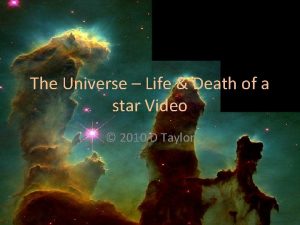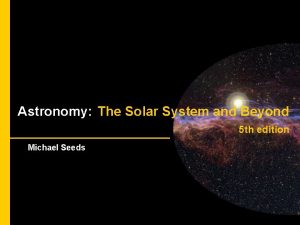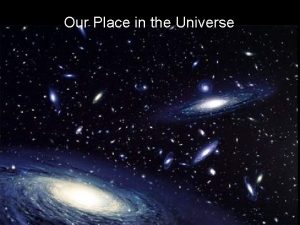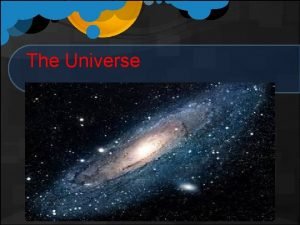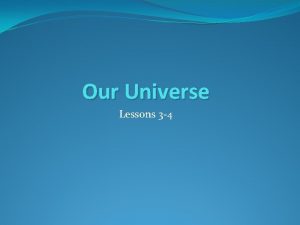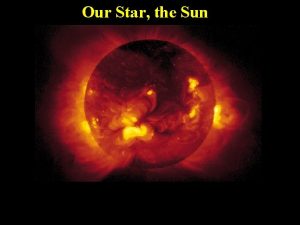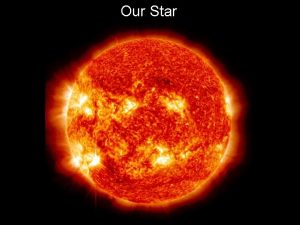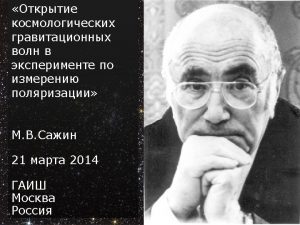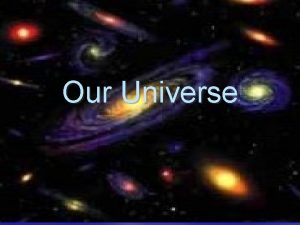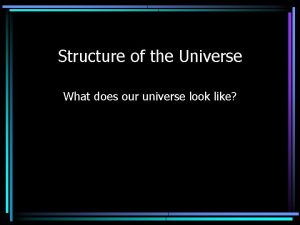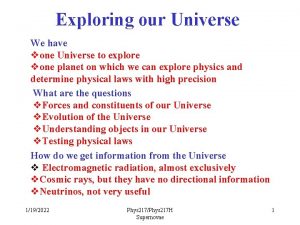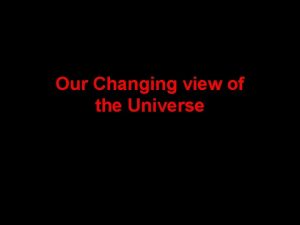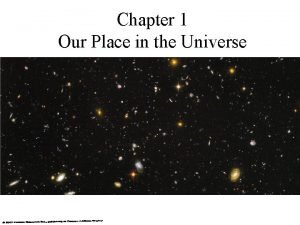What is our place in the universe Star

























- Slides: 25

What is our place in the universe?

Star A large, glowing ball of gas that generates heat and light through nuclear fusion

Planet Mars Neptune A moderately large object that orbits a star; it shines by reflected light. Planets may be rocky, icy, or gaseous in composition.

Moon (or satellite) An object that orbits a planet. Ganymede (orbits Jupiter)

Asteroid A relatively small and rocky object that orbits a star. Ida

Comet A relatively small and icy object that orbits a star.

Solar (Star) System A star and all the material that orbits it, including its planets and moons

Big Ideas in the Solar System • 1. The Earth’s climate is changing. • 2. Impacts by asteroids and comets have shaped the Earth and its environment.

3. Impacts by asteroids and comets have altered the course of biological evolution on Earth. • 4. Comets are the givers and takers of life on Earth. 5. Rocks from Mars fall on the Earth. We have found about 15 so far.

• 6. The climates of Venus and Mars may tell us about the past and future of Earth’s climate.


Galaxy A great island of stars in space, all held together by gravity and orbiting a common center M 31, The Great Galaxy in Andromeda

Universe The sum total of all matter and energy; that is, everything within and between all galaxies

How can we know what the universe was like in the past? • Light travels at a finite speed (300, 000 km/s). Destination Light travel time Moon 1 second Sun 8 minutes Sirius 8 years Andromeda Galaxy 2. 5 million years • Thus, we see objects as they were in the past: The farther away we look in distance, the further back we look in time.

Example: We see the Orion Nebula as it looked 1, 500 years ago. M 31, The Great Galaxy in Andromeda

Example: This photo shows the Andromeda Galaxy as it looked about 2 1/2 million years ago. Question: When will be able to see what it looks like now? M 31, The Great Galaxy in Andromeda

Light-year • The distance light can travel in one year. • About 10 trillion km (6 trillion miles).

• At great distances, we see objects as they were when the universe was much younger.

The Cosmic Calendar Figure from Prologue: Very Important !

How do our lifetimes compare to the age of the Universe? • The Cosmic Calendar: a scale on which we compress the history of the universe into 1 year.

How do our lifetimes compare to the age of the Universe? • The Cosmic Calendar: a scale on which we compress the history of the universe into 1 year.

How is Earth moving in our solar system? • Contrary to our perception, we are not “sitting still. ” • We are moving with the Earth in several ways, and at surprisingly fast speeds… The Earth rotates around its axis once every day.

Earth orbits the Sun (revolves) once every year: • at an average distance of 1 AU ≈ 150 million km. • with Earth’s axis tilted by 23. 5º (pointing to Polaris) • and rotating in the same direction it orbits, counterclockwise as viewed from above the North Pole.

Our Sun moves randomly relative to the other stars in the local Solar neighborhood… • typical relative speeds of more than 70, 000 km/hr • but stars are so far away that we cannot easily notice their motion … And orbits the galaxy every 230 million years. •

Are we ever sitting still? Earth rotates on axis: > 1, 000 km/hr Earth orbits Sun: > 100, 000 km/hr Solar system moves among stars: ~ 70, 000 km/hr Milky Way rotates: ~ 800, 000 km/hr Milky Way moves in Local Group Universe expands
 Myrrh is mine its bitter perfume
Myrrh is mine its bitter perfume The life and death of a star
The life and death of a star A* and ao* algorithm difference
A* and ao* algorithm difference What does star events stand for?
What does star events stand for? Many students work on the star our school newspaper
Many students work on the star our school newspaper Dark patch on our star
Dark patch on our star Millions billions trillions chart
Millions billions trillions chart A wave is a disturbance that transfers
A wave is a disturbance that transfers A disturbance that transfers energy from place to place
A disturbance that transfers energy from place to place Our awareness of ourselves and our environment
Our awareness of ourselves and our environment We bow our hearts
We bow our hearts Awareness of ourselves and our environment is:
Awareness of ourselves and our environment is: Our census our future
Our census our future Our awareness of ourselves and our environment is called
Our awareness of ourselves and our environment is called Our life is what our thoughts make it
Our life is what our thoughts make it Our census our future
Our census our future God our father christ our brother
God our father christ our brother Christ, be our light shine in our hearts
Christ, be our light shine in our hearts Money madness poem line by line explanation
Money madness poem line by line explanation Our future is in our hands quotes
Our future is in our hands quotes Marcus aurelius our life is what our thoughts make it
Marcus aurelius our life is what our thoughts make it Awareness of ourselves and our environment is
Awareness of ourselves and our environment is Thinking affects our language, which then affects our:
Thinking affects our language, which then affects our: ưu thế lai là gì
ưu thế lai là gì Hệ hô hấp
Hệ hô hấp Tư thế ngồi viết
Tư thế ngồi viết

